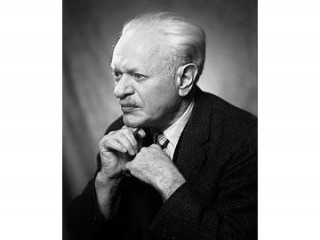
Kenneth Burke biography
Date of birth : 1897-05-05
Date of death : 1993-09-19
Birthplace : Pittsburgh, Pennsylvania, U.S.
Nationality : American
Category : Famous Figures
Last modified : 2011-09-02
Credited as : Literary theorist, ,
Kenneth Burke was a literary theorist and critic whose work was influential in several fields of knowledge where symbols are a central focus of study.
Kenneth Duva Burke was born in Pittsburgh, Pennsylvania, on May 5, 1897. Burke dropped out of college twice, first from Ohio State and then from Columbia, preferring to study on his own. He wanted to write rather than follow the path toward a college professorship. He became part of the literary culture of Greenwich Village, supported by a small allowance from his father. In 1919 Burke married Lillian Batterham, with whom he had three daughters. In 1933 he divorced Lillian and married her sister, Elizabeth, with whom he had two sons.
Burke participated fully in the literary and academic culture of the 1920s. Thereafter, although he was influenced by both Marx and Freud and held several academic positions, he never allowed himself the ease of dogmatism or the security of a permanent academic appointment. His many books are an unusual combination of powerful and original theory marked throughout by paradox, erudition, and a comic spirit.
Burke's early interest in poetry, music, and literature soon turned theoretical, and he began to explore the ways in which poetry and criticism could explain human relations in general. In a series of major works Burke began to explore literature not only as a potential social influence and reflection of social attitudes, but as a model of the structure of human action. Human action, said Burke, is essentially symbolic action, shaped and motivated as if it were drama. Hence, he used the term dramatism to describe a way of studying human motivation. The key to dramatism is that human action is free and purposeful, as opposed to motion, which is simply the physical movement of objects. Humans act, said Burke, and objects move. The structure of human action is dramatic, based on interaction of the five sources of motive that Burke identified in A Grammar of Motives (1945) as the pentad: act, agent, agency, purpose, scene (what was done, who did it, by what means, to what end, and where and when?).
In A Rhetoric of Motives (1950), Burke wrote that rhetoric, or persuasion, is central to any study of the human condition, defining rhetoric as "the use of language as a symbolic means of inducing cooperation in beings that by nature respond to symbols." The key to Burke's concept of rhetoric is identification, a recognition of common interests or common "substance," with other humans and is based on the ever-present opposite of identification, division. Rhetoric preserves or alters social order by influencing the way people perceive their symbolic relations. Although rhetoric is historically rooted in language, Burke extended its operation to any human activity in which meaning could be found, and that means all human action. "Wherever there is persuasion, there is rhetoric. And wherever there is 'meaning,' there is 'persuasion."'
Because all human action is meaningful and therefore persuasive, both for its author and its audience, Burke thought of all symbolic behavior as strategic action that is directed at defining situations and attitudes for ourselves and others. But Burke noted that though rhetoric is inherently aimed at inducing cooperation by healing division, it can also lead to the futile and coercive attempt to create perfect unity.
In The Rhetoric of Religion (1961), Burke turned his attention to what he called logology, his term for the general study of language and symbols. In this and other works, Burke showed that humans organize their perceptions, their languages, their societies, and their religions on the basis of hierarchies, as in the religious ascent from earthly to eternal life. Burke claimed that a major human invention is the negative, which is what makes symbolic meaning and consequent human society possible, because all notions that something is depend on the implicit claim that it is not something else. The human desire for order and perfection leads to cycles of guilt-victimage-purification-redemption, such as that embodied in the Christian religion and reenacted, said Burke, throughout our history and daily experience. A life's work led Burke to his definition of man, set forth in Language as Symbolic Action (1966). He claimed, "Man is/the symbol-using (symbol making, symbol-misusing) animal/inventor of the negative (or moralized by the negative)/separated from his natural condition by instruments of his own making/goaded by the spirit of hierarchy (or moved by the sense of order)/and rotten with perfection."
Burke's work was distinguished by its application of elements from both anthropology and psychoanalysis. Many hailed his use of these sciences, but others felt he neglected to fully apply their methodologies, instead, opting for a sort of smorgasbord approach, in which he took only the aspects that he wanted. In Psychoanalysis & American Literary Criticism, Louis Fraiberg describes Burke's approach. Fraiberg contends, "Psychoanalysis cannot exist without words, but this does not mean that words are the only things in it that matter. Burke has been guilty of taking the part for the whole, and this has thrown his entire critical view out of focus." While Burke had some detractors, he also had the support of notable literary figures such as W.H. Auden and John Crowe Ransom.
Burke received many awards in his lifetime, including the Creative Arts Award from Brandeis University in 1967, the National Endowment for the Arts award in 1968, the National Council on the Arts award in 1969, the gold medal from the National Institute of Arts and Letters in 1975, and the National Medal for Literature in 1981. He also received the Elmer Holmes Bobst Award in 1984. Burke received fellowships from numerous organizations, such as the Princeton Institute for Advanced Study (1949), Stanford University (1957), and the Rockefeller Foundation (1966). He died of heart failure on November 19, 1993, in Andover, New Jersey.
















